MASERATI BROTHERS
![]()
Diatto and the Maserati Brothers With the presentation of the Diatto 20 Type designed by Engineer Coda, at the Milan Exhibition of 1922, the Maserati brothers began to work closely with Diatto. They tested and drove the famous 20 S. Given their fame and racing success Diatto was keen on entering the Grand Prix Formula with 2-litre supercharged engines, and needed the help of an expert team. A new light alloy supercharged 1,995 cc 8-cylinder engine was developed with two overhead camshafts. The new car made its debut in the 1925 Italian Grand Prix, and was driven by Emilio Materassi. After the race the engine size was changed. Using the Maserati logo, the car won over 100 races in the following years: the birth of the world famous Maserati auto manufacturing company.

![]()
Diatto and the Maserati brothers:
Rodolfo
Maserati, a Railway worker in Piacenza, married Carolina Losi and moved to
Voghera, close to Pavia. They had seven sons: Carlo (1881), Bindo (1883),
Alfieri (1885), who died after only a few months. The same name was given to
their next son, born in 1887, followed by Mario (1890), Ettore (1894), and
Ernesto (1898).
 Mario
became an artist but the other five brothers all showed an interest in
engineering, a new science, associated with the development of the combustion
engine. Nonetheless, in 1926 Mario gave his brothers a hand in designing the
Maserati logo, Neptune’s trident, the symbol of Bologna.
Mario
became an artist but the other five brothers all showed an interest in
engineering, a new science, associated with the development of the combustion
engine. Nonetheless, in 1926 Mario gave his brothers a hand in designing the
Maserati logo, Neptune’s trident, the symbol of Bologna.
In
chronological order, Carlo was the first to show an interest in the auto
industry. But things being what they are, he began work in a bicycle factory in
Affori, close to Milan. At the age of 18 he designed a single-cylinder motor to
use with a bicycle, creating a motor cycle. At this time the auto industry was
beginning to attract investments, previously put into other, more profitable,
industrial activities. Carlo Maserati’s invention attracted the attention of
Carcano, a nobleman from Anzano del Parco, near Lecco. The new Carcano motor
cycles were tested by Maserati in Brianza and then used in competition events
from 1899 on, with great success. This phase ended on 9-10 September 1900, with
dual victory: the 2¾ HP at the 5-kilometer speed trial, and the
Brescia-Cremona-Mantua-Verona-Brescia race.
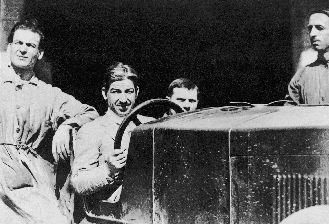 In
Brescia, Maserati met Vincenzo Lancia, who introduced him to Fiat, a new
company full of enthusiasm and energy. Maserati left Fiat in 1903 to join the
technical staff of Isotta Fraschini and test the engines and new vehicles.
Attracted by motor racing, in 1907 Bianchi hired a new engine designer,
Giuseppe Merosi, but the results were disappointing. Carlo Maserati finished
ninth at the Kaiserpreis on the Taunus race track in Germany and seventh in the
Florio Cup in Brescia.
In
Brescia, Maserati met Vincenzo Lancia, who introduced him to Fiat, a new
company full of enthusiasm and energy. Maserati left Fiat in 1903 to join the
technical staff of Isotta Fraschini and test the engines and new vehicles.
Attracted by motor racing, in 1907 Bianchi hired a new engine designer,
Giuseppe Merosi, but the results were disappointing. Carlo Maserati finished
ninth at the Kaiserpreis on the Taunus race track in Germany and seventh in the
Florio Cup in Brescia.
In 1908
Maserati left Bianchi to join Lorraine-Dietrich, as mechanic to Vincenzo Trucco
for the Florio Cup in Bologna. He was then appointed Director General of a
small company called Junior, in Milan, part of the Ceirano Group. In 1910,
Carlo Maserati fell ill and died prematurely as he was getting ready to launch
a new car with the company.
Alfieri, his brother, had a similar temperament, despite
his youth. In 1903, after briefly working in a private workshop, he was hired
by Isotta Fraschini in Milano, on Carlo’s recommendation.
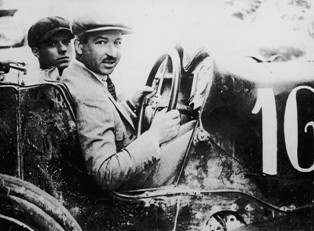 An extrovert, with captivating character, Alfieri soon
became an important part of the team and ace driver. He debuted as a mechanic,
helping Trucco, but in 1908 he was given a car of his own, the 1.2-litre FE for
the Dieppe Grand Prix, where he finished 14th despite carburettor problems. In
1911 he was promoted and moved first to Argentina, then to London, with his
brother Ettore.
An extrovert, with captivating character, Alfieri soon
became an important part of the team and ace driver. He debuted as a mechanic,
helping Trucco, but in 1908 he was given a car of his own, the 1.2-litre FE for
the Dieppe Grand Prix, where he finished 14th despite carburettor problems. In
1911 he was promoted and moved first to Argentina, then to London, with his
brother Ettore.
The following year the two brothers returned to organize
the spare parts and repair workshop in Bologna. In 1914, confident of his
abilities, Alfieri took the plunge, becoming self-employed.
He opened a workshop in via de’ Pepoli, Bologna, called
Società Anonima Officine Alfieri Maserati. He and his brother Ettore were
called up and served in the First World War. At this time, Bindo was working at
Isotta Fraschini as test technician, so Ettore kept an eye on the workshop in
Bologna with its 5 employees.
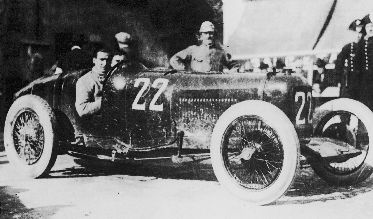 After military service, and before the end of the war,
Alfieri started a new business in Milan, making starting plugs with mica
insulation, an important, though secondary, business activity. After the war,
he returned to motor racing, helped by his brother Ernesto. The company moved
to larger premises in Alemanni, on the eastern outskirts of Bologna, an area
better known as Ponte Vecchio.
After military service, and before the end of the war,
Alfieri started a new business in Milan, making starting plugs with mica
insulation, an important, though secondary, business activity. After the war,
he returned to motor racing, helped by his brother Ernesto. The company moved
to larger premises in Alemanni, on the eastern outskirts of Bologna, an area
better known as Ponte Vecchio.
The factory, on 2 floors, was originally used for
carboys, had three large windows looking out onto the via Emilia. The ground
floor was used as a warehouse and the top floor as offices and the home of the
brothers. The workshop proper was at the back, a rather modest looking building
in a courtyard with orchard (looked after by their father). The sparking plug
business was moved to these premises, leaving only the dealership in Milan, in
the hands of Amedeo Polacchini. The workshop specialises in tuning engines and
changing body work to make standard cars competitive for motor racing. The
activities meet customer requirements but also fulfil Alfieri’s passion.
Customers are Isotta Fraschini, but also other auto manufacturers.
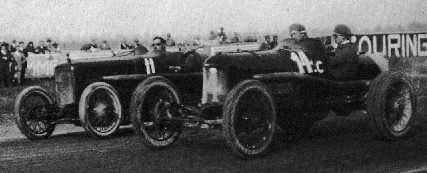 In 1920, Alfieri Maserati took part in the second motor
race in Italy after the war, on the Mugello race track, driving a 2,562 cc
4-cylinder Nesselsdorf, part of the war equipment Maserati had bought. The car
was not strong enough to last the race and Maserati and 5 other competitors in
the same class failed to finish. After showing some brief interest in a 3-litre
SCAT for the 1920 Parma-Poggio di Berceto, Alfieri Maserati made what can be
described as the first Diatto Maserati, a powerful car with Diatto frame and
4-cylinder 6,330 cc Isotta Fraschini engine (bore: 120 mm, stroke: 140 mm). It
was a hybrid, one of many at that time, partly due to the disinterest of auto
manufacturers and partly to the availability of aircraft engines after the war.
In 1920, Alfieri Maserati took part in the second motor
race in Italy after the war, on the Mugello race track, driving a 2,562 cc
4-cylinder Nesselsdorf, part of the war equipment Maserati had bought. The car
was not strong enough to last the race and Maserati and 5 other competitors in
the same class failed to finish. After showing some brief interest in a 3-litre
SCAT for the 1920 Parma-Poggio di Berceto, Alfieri Maserati made what can be
described as the first Diatto Maserati, a powerful car with Diatto frame and
4-cylinder 6,330 cc Isotta Fraschini engine (bore: 120 mm, stroke: 140 mm). It
was a hybrid, one of many at that time, partly due to the disinterest of auto
manufacturers and partly to the availability of aircraft engines after the war.
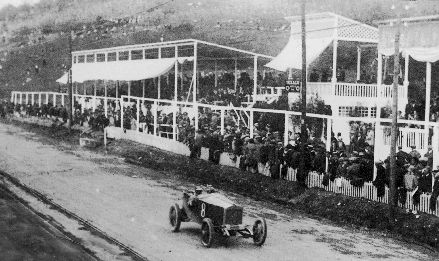 The official name was Special Type. Alfieri Maserati
drove it on 24 July 1921 on the Mugello race track, coming second in his class
and fourth overall. One month later, with Ernesto acting as mechanic, he won
the Susa-Moncenisio, beting the Peugeot driven by Samy Réville.
The official name was Special Type. Alfieri Maserati
drove it on 24 July 1921 on the Mugello race track, coming second in his class
and fourth overall. One month later, with Ernesto acting as mechanic, he won
the Susa-Moncenisio, beting the Peugeot driven by Samy Réville.
The season reached a peak with a full week’s racing in
Brescia, a disappointment for Italian auto manufacturers. Alfieri Maserati took
part in the kilometer race with flying start to qualify for the Gentleman’s
Grand Prix featuring Campari’s Alfa, Masetti’s Mercedes (the winner), Niccolini’s
Fiat and Baroness Maria Antonietta Avanzo driving an Alfa ES sport. Alfieri
Maserati came fourth overall, taking first prize for his class. The car had
2-wheel drive and experimental puncture-proof tyres supplied by Società Gomme
Imperforabili of Florence.
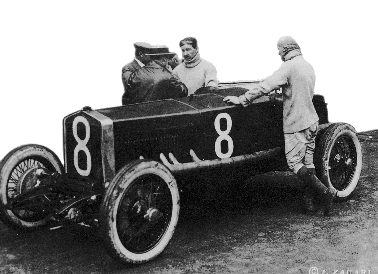 The car was further improved in 1922 with Goodrich tyres,
Magnete Marelli parts instead of Bolis, a potentiometer fitted to the brake
system and lightweight design, a key feature.
The car was further improved in 1922 with Goodrich tyres,
Magnete Marelli parts instead of Bolis, a potentiometer fitted to the brake
system and lightweight design, a key feature.
Alfieri and Ernesto were inseparable partners, winning at
Mugello and beating the track record and all the higher ranked competitors in
the race. This success was followed by similar records at Susa-Moncenisio and
Aosta-Gran San Bernardo.
The success was due to Maserati’s skill as a technician
and driver, attracting the attention of Diatto, which launched the 20 Type at
the Milan Exhibition of 1922. The car was designed by Engineer Coda with the
help of Lardone. Maserati joined the team as test driver for the 20 S Type. To
get things done quicker, Alfieri and Ernesto moved to Turin to prepare for the
1922 Italian Grand Prix. Torrential rain ruined the race. Guido Meregalli and
Alfieri Maserati, the two Diatto drivers, failed to finish (mechanical failure
and accident).
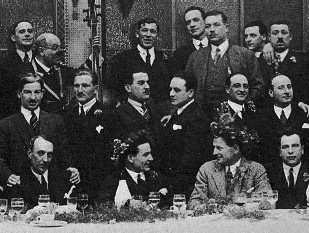 Despite this setback, Diatto was pleased with the work
done and on 22 October Alfieri Maserati drove a 3-litre 4-cylinder Diatto to
success in the Autumn Grand Prix in Monza, ahead of the Alfa Romeo RL driven by
Sivocci and the new 4-cylinder Bianchi driven by Costantini.
Despite this setback, Diatto was pleased with the work
done and on 22 October Alfieri Maserati drove a 3-litre 4-cylinder Diatto to
success in the Autumn Grand Prix in Monza, ahead of the Alfa Romeo RL driven by
Sivocci and the new 4-cylinder Bianchi driven by Costantini.
At the Florio Cup, the last race of the season in Sicily,
Alfieri came close to beating the Peugeut driven by André Boillot, running out
of oil between Caltavuturo and Polizzi. Maserati tried olive oil, but failed to
reach the finishing line.
The victory of Maserati at Monza and of Meregalli on
Garda Lake, with the Diatto 20, fired the company’s ambitions, leading them to
back Maserati’s idea of a new car powered by 4.5-litre 8-cylinder Hispano-Suiza
engine modified by Diatto.
 The car won the Susa-Moncenisio, with Maserati at the wheel,
his third win in a row and worth the Prince Amedeo Cup. The following make
driver and car also won at Aosta-Gran San Bernardo. In 1924 the 4.5-litre
Diatto was often left idle, as smaller engined gained preference. Ernesto
Maserati began his racing career at the wheel of a 3-litre Diatto, winning his
class in Pistoia Hills race.
The car won the Susa-Moncenisio, with Maserati at the wheel,
his third win in a row and worth the Prince Amedeo Cup. The following make
driver and car also won at Aosta-Gran San Bernardo. In 1924 the 4.5-litre
Diatto was often left idle, as smaller engined gained preference. Ernesto
Maserati began his racing career at the wheel of a 3-litre Diatto, winning his
class in Pistoia Hills race.
At the San Sebastian GP, on 27 September, staged on the
Lasarte race track, Alfieri Maserati came close to beating the alliance between
Bugatti, Delage and Sunbeam, his Diatto 20 S engine breaking down when he was
in contention.
In 1924 Maserati was at the centre of fierce debate. The
rather absurd question was focused on the uphill race in Rebassada, near
Barcelona, which took place on 25 May. Diatto has strong interests in Spain, so
Luigi Mora, the agent, entered Maserati with a 2-litre engine. On the eve of
the race Alfieri Maserati replaced the engine with a 3-litre. Ferdinand De
Vizcaya, taking part with a 4.4-litre 8-cylinder Elizade, somehow got to hear
about it (rumour has it he was told by a priest) and protested. Seven months
later, international racing authorities disqualified Maserati from racing for
five years. Mora and Diatto were also disqualified.
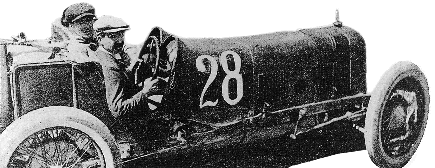 Subsequent investigations established that Diatto knew
nothing of the idea and the ban was lifted. Diatto was allowed to continue
racing and this time chose Alfieri’s brother, Ernesto, who was given a 2-litre
Diatto, together with Carlo Lecot and Diego De Sterlich with a 4.5-litre
engine.
Subsequent investigations established that Diatto knew
nothing of the idea and the ban was lifted. Diatto was allowed to continue
racing and this time chose Alfieri’s brother, Ernesto, who was given a 2-litre
Diatto, together with Carlo Lecot and Diego De Sterlich with a 4.5-litre
engine.
The company was coming through a time of hardship and
wanted to renew its commitment to racing in 1925. The 20 S Type was highly
successful, but Diatto wanted to move into Grand Prix racing, where
supercharged 2-litre engines were required.
Alfieri Maserati was given the job of developing the
engine. The new engine had 8 cylinders and was made of lightweight alloy, with
two overhead camshafts. It was a 2-litre engine (1,995 cc) with 65.5 mm bore
and 74 mm stroke. Four Zenith carburettors were used initially. The engine was
fitted to a new frame and took part in the Susa-Moncenisio, on 5 July, with
Onesimo Marchisio, test driver and former Fiat racing driver. One month later
he was killed in the Maddalena race, driving the new Diatto. This tragedy held
up the fine-tuning required for the engine (requiring Maserati to spend a great
deal of time in Turin) and forced Diatto to look for new drivers. Rumours have
it that Alfieri would be allowed to return to racing if Diatto took part at San
Sebastian, and this was the final solution one year later.
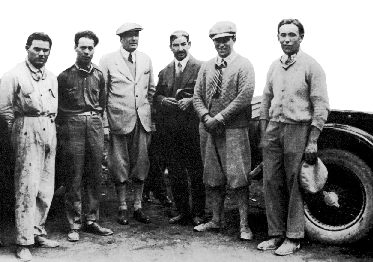 The only solid point of reference in the team was the
driver Emilio Materassi, a close friend of Alfieri Maserati. The second car was
up for grabs, between Diego De Sterlich, Rubietti and the Spaniard Antonio
Garcia. This was the run up to the 1925 Italian GP, with Diatto still in high
water.
The only solid point of reference in the team was the
driver Emilio Materassi, a close friend of Alfieri Maserati. The second car was
up for grabs, between Diego De Sterlich, Rubietti and the Spaniard Antonio
Garcia. This was the run up to the 1925 Italian GP, with Diatto still in high
water.
Two cars were taken to Monza, but only one was a final
version, with Rots compressor, able to generate 150 HP at 5,200 rpm. Materassi
was given the prestige car and a further 14 competitors started the race out of
a much more numerous field of 2-litre engines: three Alfa Romeo, two
Duesenberg, one Guyot special and the Diatto. In the 1,500 cc class, there were
five Bugatti, two Chiribiri and one Eldridge. The Diatto was fifth after 30
miles, behind 3 Alfas and the Duesenberg; after 60 miles the positions were the
same. The leading Alfa Romeo, driven by Campari, was lapping at an average
speed of 98.25 mph; Milton’s Duesenberg was fourth at 95.37 mph; Materassi was
a shade slower, at 93.82 mph. The sixth placed driver, in an 8-cylinder Bugatti
39 Type, was racing at 86.5 mph.
The 2-litre Diatto came close to 200 kmh (125 mph) but
after a long pit stop Emilio Materassi was forced out of the race after 250
miles. 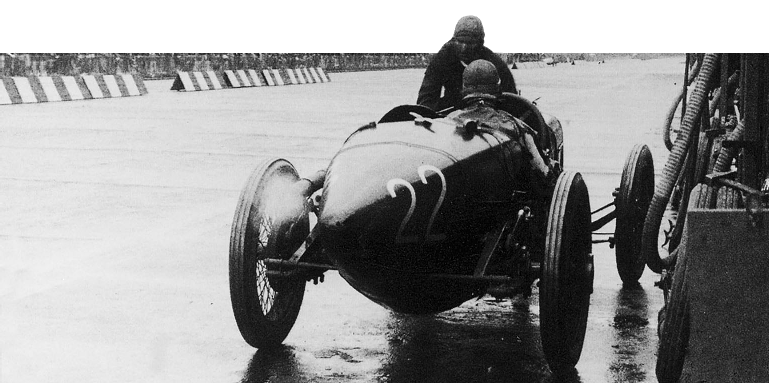
The 2-litre Diatto never raced again.
It was improved and in 1926 became the Tipo 26, with the Masertati trident
logo, a car that was destined to make motor racing history with over one
hundred victories.





